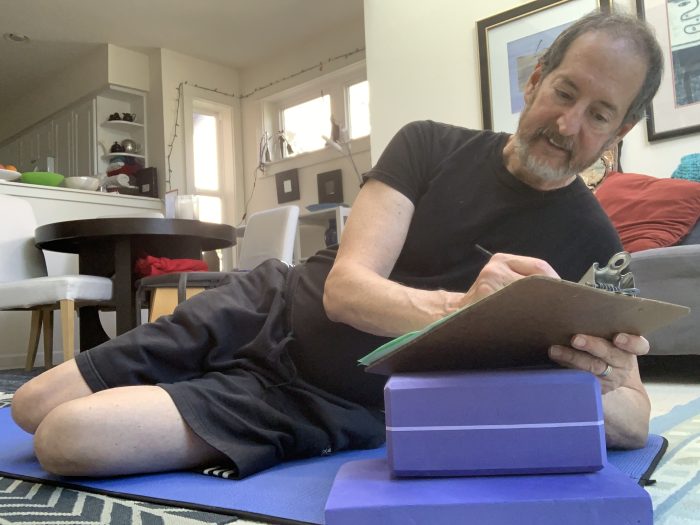During the past dozen years, I’ve experimented with different forms of journaling about my experiences in yoga.
But I’ve never thought systematically about my journaling. It’s as if I’ve been carrying out an ongoing journaling experiment without much conscious awareness of the different forms I’ve been using and the purposes they’ve served.
I’d like to make my yoga journaling practices explicit. By shedding light on the varied forms I’ve tried out, I hope to deepen my own understanding of how and why I journal. I also hope that this discussion will suggest journaling possibilities for other yoga practitioners.
In-the-Moment Journaling
One kind of yoga writing I’ve done is what I might call “in-the-moment journaling.” In this genre, I jot down on a sheet of paper or my iPad whatever salient sensations, images, emotions, and thoughts that arise in the flow of a yoga practice, with minimal interpretation. Journaling becomes a way of heightening my perception and deepening my appreciation for this field of inner experience.
For example, in a recent class, I noticed that my teacher’s instructional language was rich with imagery drawn from the elements of air, water, and earth. I also noticed that this imagery helped me settle into and glide with my body.
The teacher’s cue to “float” our feet off the floor in preparation for toe touches, a warm-up movement, was a case in point. Floating evoked in me the feeling that my feet were softly swaying in a calm breeze. Jotting down this sensation enabled me to savor the sensation and appreciate how different it was from merely raising my feet in the air.
I felt similarly about the cue to “wave” our knees from side to side in Windshield Wiper pose and then, later, in a Supine Twist. It was satisfying to sense the difference between merely lowering and lifting my knees and waving them.
And as one last example, I included in my notes the cue to “melt” our knees into our chest, suggesting a more liquid smoothness in movement than the more literal cue to pull the knees in.
Admittedly, in-the-moment journaling can be a bit distracting. Pausing during a class or a home practice to jot down observations and impressions can interrupt the flow. That’s why I often wait until the end of class to note what struck me during the session. I suppose I would refer to this variation as “almost-in-the-moment” journaling.
Journaling for Sharing
In this form of journaling, my purpose has not been simply to deepen my own experience of yoga. It’s also been to communicate and connect with my teacher or fellow members of a yoga class or community.
The basic idea of journaling, of paying close attention to what strikes me most in a class and making notes about this, either in the moment or right after class, holds true whether I’m writing for myself or to share with others. But when my purpose is to share, I always need to edit my notes to make them more coherent and relatable. I also accompany the journal entry with a personal note, typically in the form of an email message, as a bridge between the contents of my edited journal and the intended recipient.
For example, about two hours after the class mentioned earlier, I consolidated and edited the in-the-moment notes I had taken and sent the edited version to my teacher. This reinforced for me my memory of the smooth, fluid movements of the class and allowed me to convey my appreciation to my teacher for her creative and evocative use of language. When my teacher got back to me with an expression of her own appreciation for my message, I felt doubly pleased—pleased with the class experience and pleased that my communication about the experience was affirming for her.
Post-Discussion Journal Writing
Another form of yoga writing I’ve done is post-discussion journal writing. The kind of discussion I’m referring to here is the 10 or 15-minute exchange that the teacher in another one of my weekly classes facilitates at the end of each class with class members. I find these peer-sharing sessions illuminating and bonding. And in some cases, the dialogue right after class helps me to sow the seeds of memory and meaning that had been planted earlier during the class session.
For example, I have journal notes from a class in July 2020 that the teacher introduced with a poem that I loved by David Whyte called “Start Close In.” This humbly inspiring poem is about rooting into the ground beneath us, finding the voice that is distinctly our own, and taking the small, close-by, but risk-worthy steps to live a larger life.
What I wrote down about the class after our post-class discussion was something I felt during class but had not been all that conscious of and had not found words for. The discussion brought to fruition, for example, the sense that when we “hugged in toward the midline” in yoga, as when we hugged our arm bones into our shoulder sockets, we were embodying what Whyte referred to as “starting close in.” We were starting with a secure inner structure as a foundation for expanding outward.
Another note from that class discussion was the connection between starting close in and the Ujjayi breathing we were doing during part of the class. Ujjayi breathing is a kind of gentle, quiet washing of the breath over the back of the throat. In one of the poem’s stanzas, Whyte wrote about the need to follow our own voice before finding another’s. Ujjayi can represent a washing of the breath to clear away what’s holding us back from speaking our truth. This is another form of starting close in, of listening first to the sounds of our own breath before becoming a listening ear for others.
For sure, post-class discussions are not standard fare in yoga classes. So, this form of journaling may not be an option for many yoga students. But if you are fortunate enough to practice in a context in which discussions following class are built into the structure of the sessions, then journaling about not only the class experience but the discussions afterward can be rewarding.
Extended-Theme Journaling
This is the most fully developed form of journaling I do. It involves an in-depth exploration, in both body and mind, of a central theme, such as the central yogic concerns of balancing ease and effort, the feminine and the masculine, the letting go and the making happen. The themes I’m referring to are best explored in a well-sequenced series of classes rather than a single class or isolated episode of practice.
I’ve done this type of journaling when I’ve participated in yoga “immersion” programs, which typically have been a week in length, with a 75-minute class each day for five days. For example, the last two immersion programs I’ve taken have been about “the mystery of the supple spine” and about “breath magic” (see the “Sanctuary” here).
I journaled each day of these five-day sessions to track my theme-related discoveries. For example, in the program on the supple spine, I made discoveries about my tailbone, the bottommost segment of the spine, on several consecutive days. I had never thought much about my tailbone, but I learned to unfurl, wiggle, and wag this little part of me in playful ways that I noted in my journal and later wrote about in an article for Elephant Journal.
Keeping a journal in yoga can heighten our awareness and appreciation of what we are experiencing. It can also provide a basis to communicate with others, reflect on our discussions with teachers and fellow students, and develop key themes. The form of journaling we choose depends on a large extent on the context in which we are practicing and the purposes we wish to serve. As our practice contexts and purposes become more varied, so, too, might our forms of journaling.
Author’s note/acknowledgment: I probably never would have been inspired to keep a yoga journal in the first place had it not been for the wonderful instruction I’ve received for more than a decade from my two primary teachers: Leslie Ellis and Lani Jelen.
~
Please consider Boosting our authors’ articles in their first week to help them win Elephant’s Ecosystem so they can get paid and write more.












Read 4 comments and reply